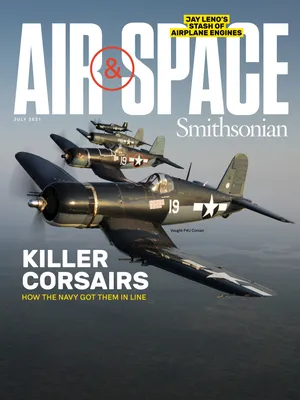A Star Trek Fan’s Dream Job
How one man makes science fiction look real.
:focal(1503x638:1504x639)/https://tf-cmsv2-smithsonianmag-media.s3.amazonaws.com/filer/e8/62/e8628d6c-2aba-4c25-b19d-fe830ccd1edb/33d_jj2021_fourdougmocr_live.jpg)
Doug Drexler is an Oscar-winning visual effects artist and designer who has worked on numerous science-fiction films and TV shows, including Star Trek: Deep Space Nine, Battlestar Galactica, and The Orville. He spoke with Air & Space senior associate editor Diane Tedeschi last December.
Air & Space: Tell me about a visual effect you’re particularly proud of.
Drexler: When I was on Star Trek, I designed several [starship] Enterprises. For me, that’s a milestone.
Where does your inspiration come from?
When you get an assignment, the first thing you want to do is to become a mini expert on it. And it’s never been easier than it is right now because I can go on the computer, and I can type in something and get 10,000 things to look at. But 25 years ago, I would have to go to the library. Now you can become a mini expert on submarines and collect several thousand photos in an afternoon. Once you educate yourself, you let it percolate. A lot of the creative process is taking in all that information and then setting it aside for a day. And then you’ll be in the shower, and ideas will start popping into your head.
Who has influenced your work?
Space artists like Bob McCall, Fred Freeman, and Chesley Bonestell. These are all guys that I grew up with—looking at their work and using it to fire my imagination. Plus, I lived in New York City, and in 1964, there was the New York World’s Fair. My dad had a TV repair store about two blocks away from the fair. And twice a week—because the fair was only there for two summers—he dropped me off at the main gate. At 11 years old! Maybe he was trying to get rid of me. [Laughs.] So I spent two summers there by myself. And the thing was all about the world of tomorrow. All about the future.
And a year after that, Star Trek [the original TV series] premiered, which has affected the whole direction of my life. It was so obvious that whoever was behind the show was a science fiction fan, which Gene Roddenberry was. So I was really impacted by that—the ideas and the way they portrayed them. And then a guy named Stephen Whitfield wrote a book called The Making of Star Trek. And that book—even today it’s a great book on how television is produced. So here I am at 13 years old, and I’m reading the show’s production memos, budgets, outlines for stories. It was an epiphany getting to read that book, and relate it to this television show. That’s really where I started training [for a career in television production].
How much artistic freedom do you have?
Well, every show is like a different circus. [Laughs.] Every director is a different ringmaster. I’ve been in situations where we’re told to do whatever we think is right. And then there are times when someone wants to micromanage. You have to be ready for anything.
Is your work always fun?
It’s never felt like a job to me. There’s nothing repetitive about it. Every day is totally different, and every day could have another issue. You have to kind of get your brain in a place where you take the difficult days, and believe me there are times that it’s abject terror. Especially if you’re doing makeup effects where you’re working in front of the camera—in front of the whole crew. Today, bullet hits and things like that can be done digitally, but back then if someone got shot, we used to have to put an appliance on them—it was a little squirt that had to go off. You never knew whether it was going to work. You could cost the company tens of thousands of dollars if that thing doesn’t work properly. So that’s stressful. You’ve got to get your head in a place where you find the pressure exciting. If you’re going to go in and be terrified and it’s working against you, you probably need to rethink what it is you’re doing. This business can be tough.
Do you like comic books?
Let me tell you, I still have my comic book collection. I was one of the early fans of the Stan Lee/Jack Kirby era of Marvel Comics. I have a couple of Jack Kirby originals that I got at a comic book convention in 1976. I bought a piece of his art for $15—it’s worth about $15,000 now.
Do you have a favorite Star Trek TV show?
I have a soft spot in my heart for Star Trek: The Next Generation because I was a big Gene Roddenberry fan, and Gene was still alive when they were doing that show. So I got to a place where I was talking to Gene Roddenberry on stage. He’d be watching me work [doing special makeup effects]. It was real dream-come-true kind of stuff.
Do you have a favorite Star Trek character?
That’s one of the things about Star Trek—it had quite a few wonderful characters. Spock was very influential to me growing up. I sometimes ask myself: “What would Spock say about this? What would Captain Kirk do?” And these characters—they had honor. They were good role models.
